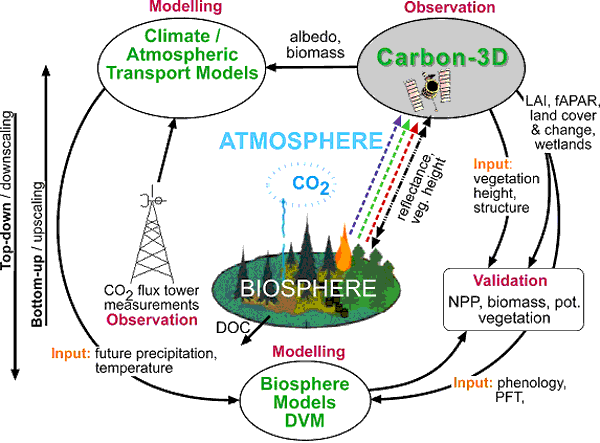 |
|
STRATEGIC POSITIONING OF CARBON-3D
The role of vegetation in reducing atmospheric levels of CO2 has been recognised in a number of international agreements (e.g. United Nations Framework Convention on Climate Change (UNFCCC), Kyoto Protocol) which specifically require countries to quantify their carbon stocks and changes. Plants store carbon in above- and below-ground biomass, 90 per cent of the above-ground carbon is stored in tree stems – which are being reduced through natural (diseases, wildfires, drought/flooding) and anthropogenic impacts (logging, pollution, human-induced fires) or vice-versa increased through regeneration or promoted growth associated with elevated CO2 levels in the atmosphere (Wardle et al. 2003).
Currently, the magnitude of the terrestrial carbon sink is considerably reduced by expanding land use. In the 1990s, terrestrial uptake has been estimated to have been 1.6-4.8 billion tons of carbon per year (GtC/yr), a notable fraction of the 6.3 GtC/yr that have been emitted from fossil fuel burning. However, losses due to land use are estimated to have amounted to 1.4 to 3.0 GtC/yr, leaving the net uptake of carbon from the atmosphere by the biosphere to have been about 1.0 ± 0.8 GtC/yr (House et al. 2003). This sink is the result of the combined changes in carbon content of vegetation, litter and soils. Changes in the carbon flux from vegetation into the litter and soil pools can be estimated from the carbon pools in vegetation. The relative magnitudes of these fluxes demonstrate the importance of interactions between atmospheric composition, biospheric biogeochemistry and land use for determining the rate of climate change.
CARBON-3D will be an essential contribution to carbon cycle investigations by providing crucial and unique data on vegetation biomass, vegetation productivity, and vegetation types and structure (compare with Figure 1). Model-based extensions of these data will also allow estimations of soil carbon stocks and dynamics with unprecedented spatial detail, and hence the land surface carbon balance. Particularly, the spatial heterogeneity of carbon-related vegetation properties, such as the status of re-growth in intensely managed forests, will be quantified.
These products will fill substantial gaps in current continental-scale carbon assessments which are specifically related to problems of spatial heterogeneity and scaling, as well as reliable quantifications of pool sizes. By observing biomass around the globe, the proposed mission will build a much needed bridge between knowledge gained at sites and the spatially poor resolved information from atmospheric inversion studies (Janssens et al. 2003). Biogeochemical process models of vegetation and soil and the associated carbon and water fluxes will benefit from the upscaling and validation data that will be available and it will be possible to assimilate the observations into these simulations.

Figure 1. Role of CARBON-3D in the observation and modelling strategy of the carbon cycle.
Vegetation biomass is the direct result of vegetation productivity, that is, of the net carbon exchange between the atmosphere and the photosynthetically active tissues of plants. Estimates of net primary production will be improved by not only using estimates of absorbed light, as do current satellite-based algorithms, but also the observed vegetation structure in terms of types and age. This will provide a firm basis for the estimation of autotrophic respiration, a critical but highly uncertain component of previous satellite-driven global model estimates of net primary production.
The implications of changes in biomass for the atmospheric greenhouse gas balance and the future evolution of climate change is critical. The temporal and spatial variations in observations of atmospheric CO2 contain a strong biospheric signal. There is substantial evidence from model studies that the current role of the terrestrial biosphere as a net sink for CO2, and therefore a brake on the build-up of anthropogenic CO2 in the atmosphere could be reversed during this century as a result of climate change.
|
 |
 |





